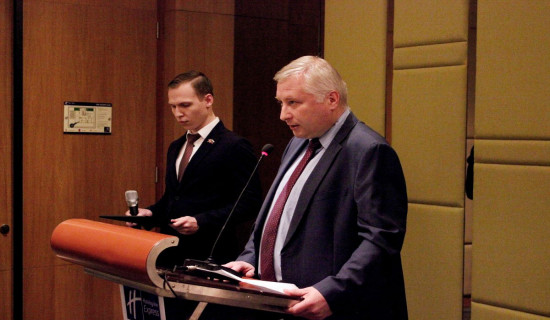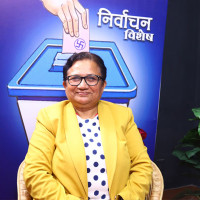- Tuesday, 23 December 2025
Virtual Reality's Grip On Political Discourse
Political parties are the products of the Industrial Revolution, capitalism and modernity, where ideologies of two classes — the capital and the labour represented social and economic interests of people in the electoral race. The binary worldview dominated political parties, polity, education, media and the constitutional system. The resilience of capitalism negotiated a social contract where the interests of haves and have-nots were balanced by the distribution of tax and welfare benefits to the poor. But later neo-liberal revolt of the haves, rooted in techno-feudalism, skewed the welfare benefits and ignited the rage of the oppressed. Even climate change was left at the mercy of market forces. It had prompted them to utilise the power of digital space to build networks and organise solidarity for collective action.
The Information Revolution subverted the political culture of industrialism, made each analytic with smartphones and digital access and claimants of constitutional and human rights. Digital web provided connectivity to the wider world through virtual communication, support for the causes of people and offered alternatives to command and control parties and syndicated regime in civic engagement beyond passion and promise of cultic leadership. New leadership shifted this trend to purpose and commitment for accountability, justice and responsive rule.
Information-driven energy
Information-driven energy: The Information Revolution has implications for the formation, function, organisation, communication and actions of Nepali political parties. It has made decision-making instant and horizontal than the hierarchically dominated and largely bureaucratised political parties with centralised leadership built on total conformism. The right to information has made public affairs in Nepal transparent, while an emotional whiff electrified the minds of a critical mass of Generation Z (Gen Z) in sight, sense, sound and touch and synchronised their action in the political landscape beyond the partisan formation of parties.
Their flexible response to stimuli leveraged the message to all members and motivated their virtual worlds to emotionally swarm against the coalition government. Nepali Gen Z’s September 8-9 nationwide protest against social media barricades set off with offering bouquets to police bore breathtaking effects. The police bullet killed 19 innocent youths but failed to subdue their ire. It scaled up new heights as they were guided by the ideals for the nation’s better future. The direct cause of this revolt is the government’s request to 26 foreign companies to register their operation, which they defied.
The official closure of social media has blown up intense anguish, resistance and rebellion of this group. The proximate causes, such as massive corruption, joblessness and economic decline, set a structural context for grievance building and political fury. Gen Z groups have, however, disclosed that agent saboteurs from the old parties, deep state agents and miscreants have infiltrated their revolt and destroyed public and private property, party offices, looted 1,276 police rifles and pistols and broken many jails, allowing about 14,000 prisoners to flee. The failures of police and armed police left the nation with a security vacuum and anomie.
The denial of the Nepal Army to crack down on protestors had forced the Prime Minister KP Sharma Oli to resign. So far, the death toll has reached 74 persons, while hundreds are mutilated. The wretched condition of the nation reappeared vividly in the cognition and structure of Gen Z political action. The negotiation between President Ramchandra Paudel and Gen Z groups, facilitated by Chief of Army Staff Ashok Raj Sigdel and Mayor of Kathmandu Balen Shah, seemed uneasy. The consent of top leaders of old parties eased the dissolution of the parliament and appointment of former Chief Justice Sushila Karki to the post of Prime Minister.
But the old leadership of eight parliamentary parties forged a chord to revive the dissolved parliament through litigation and constitutional status quo without any resonance of melody. The Prime Minister refused to accept the president's request to include party representatives in the cabinet. Later, a three-member high-level commission of inquiry was formed under former chairman and judge of the Special Court Gauri Bahadur Karki, to investigate the excessive use of force. Civil society asserts that unpunished crime infects justice, legitimises violence and ruins Gen Z’s aim to put up corruption-free rule.
The velocity of collective action: The triumph of Gen Z revolt was matchless in terms of scale, intensity and time of just two days compared to the 1950 democratic struggle consuming several years, the movement of 1990 whose victory took 50 days, one-decade of Maoist revolt beginning from 1995 and fusion of Maoist and parliamentary parties’ agitation of 2005 which took several months to fructify. All these revolts have set four common patterns: political change in Nepal has emerged through extra-constitutional means, urban networks of critical mass linked the periphery of the nation in its stirring web, each movement changed not only government but also regime and each resonated false dawn in its deep impulse.
Why did the party intellectuals fail to read the early warning of the seething crisis, which was already revealed in the earlier local and national elections and daily protests in the streets? Was the arrogance of top leaders keep them disconnected from the evolution of a new information-driven critical mass demanding democracy in the party's life? Old parties’ due diligence seemed blunted by their intellectuals’ co-option in the materiality of power and failure to monitor the welling up fury of Gen Z, breathing emotional outbursts of their collective energy. Top leadership bias in handling internal contradictions prompted sensible cadres to engage in neurotic rumination on the need to initiate party reforms and renegotiate intergenerational leadership.
Will the revolt break the political culture of cronyism, negation, impunity and privilege and enable political parties to think outside their partisan frame to capture a national perspective and people’s needs and rights? Or lead to a counter revolution through the unity of the opposite of old parties, sensing fear of the subversion of secular, federal, democratic republic? The first question is hard to answer as it is related to a high dose of civic education and renovation of civic culture. Alternative leadership blames their senior leaders for representing neither the sanity of national tradition nor the aspiration of youth for modernity and inner party democracy.
Robust support from the security agencies, youths and non-traditional parties, the young generation of leaders and their readiness to reform the parties before the elections slated for March 5, 2026, can easily sterilise counter-revolution. The shred of doubt about it is prompting Gen Z to demand a powerful commission against grand corruption perpetrated since 1991, nationalise their properties and abolish the already decrepit constitution to penalise the deep state and its geopolitical nexus.
The flaws of vertical rigidity of parties: Nepali political parties of all hues are formed through five processes: democratic struggle, party splits, fragmentation of parliamentary parties, revolts and social movements. With the putrefaction of their identities and ideologies, most of them have become catch-all and lost organic solidarity with their social base. The ability of young Nepalis to use information technology, interpret ideology, organisational control and ability for collective action has created a tension between increased deliberation, participation and judgment about leaders’ demeanour, roles and lies and a disjuncture between constitutional promise and ecological, social, economic and political indicators blinking red.
Nepali leaders trained in conventional party politics failed to engage people in the choice they made, which is less beneficial to them than their cronies, clients, followers and power brokers. They even failed to read the constitutional ideals of social inclusion couched in inner-party democracy. Despite their fighting ability for democracy and exhilarating promises, they failed to perform optimally and create the stake of people in party politics and party-led government.
Digital platforms have challenged the interest-based formation of parties, their ideologies, hierarchy, communication and decision style and opened new channels of communication, socialisation, mobilisation, participation, interest articulation and swift action. The dim rumination of nauseating old leaders stepped up the courage of Gen Z to fight and forge ahead with a better spectacle.
Mal-adaptation of old parties: The revolt of Nepali Gen Z reflects the institutional failure of parties and erosion of the authority of police, armed police force and civilian administration, which brought the sudden downfall of the regime. The media portrays it as a colour revolution where new leaders in the government have emerged outside the parliamentary and constitutional process and they are given the mandate to hold elections within six months, resolve the nation’s malaises and bring new forces in politics to set the internal and geopolitical in the right track.
Fair elections
Will it provide a politics-friendly milieu for free and fair national elections to bring new transformational leadership? Given the unorganised nature of Gen Z groups and deep fissures within, the weakness of alternative leadership in the mainstream parties, the persistence of the constitution, all the constitutional bodies and the election system, a new civic culture vital for stability is less likely to evolve. The unity of democratic and patriotic elements is vital to uphold the guts of Gen Z for a receptive rule.
The vitality of the feedback loop: Social disconnect of the old political class and closure of the feedback loop blurred their ken of what is happening in the virtual world and on the ground. The common demand orientation of Gen Z groups and reformist elements in the old parties, backing of security agencies and international legitimacy provided a new context and a hope for them to counterbalance cultic figures through their web in a virtual sphere fused with the pressure to change ground reality. But they need to strengthen organisational structure, craft a common minimum programme for transition management and build state-people coherence for democratic stability ruptured by old parties and geopolitical reengineering of the nation.
(Former Reader at the Department of Political Science, TU, Dahal writes on political and social issues.)
















